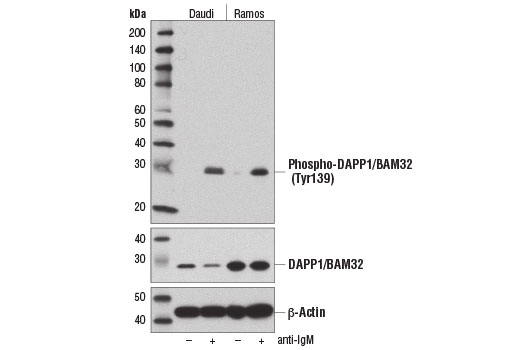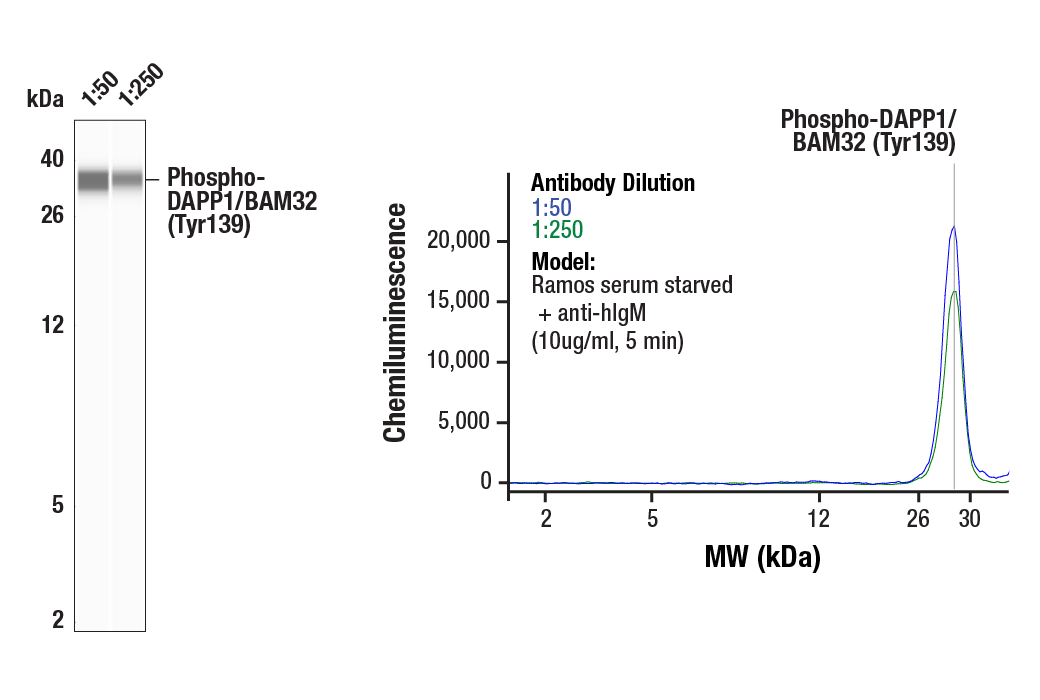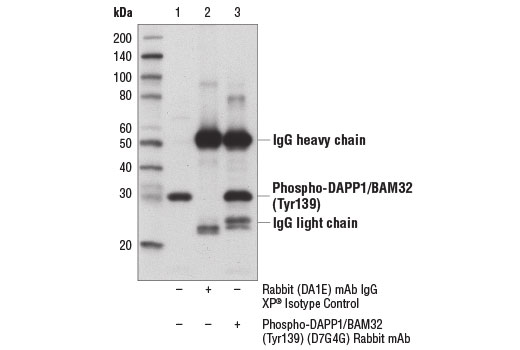WB, W-S, IP
H
Endogenous
29
Rabbit IgG
#Q9UN19
27071
Product Information
Product Usage Information
| Application | Dilution |
|---|---|
| Western Blotting | 1:1000 |
| Simple Western™ | 1:50 - 1:250 |
| Immunoprecipitation | 1:200 |
Storage
Specificity / Sensitivity
Species Reactivity:
Human
Source / Purification
Monoclonal antibody is produced by immunizing animals with a synthetic phosphopeptide corresponding to residues surrounding Tyr139 of human DAPP1/BAM32 protein.
Background
The dual adaptor of phosphotyrosine and 3-phosphoinositides (DAPP1/BAM32) is a cytoplasmic adaptor protein that mediates the recruitment and interaction of molecules required for signal transduction downstream of the B cell receptor (BCR) (1). The DAPP1/BAM32 protein contains an amino-terminal SH2 domain and a carboxy-terminal pleckstrin homology (PH) domain that binds to PI3K-derived phosphoinositides (i.e., PIP3). Upon BCR activation, DAPP1/BAM32 is phosphorylated at specific tyrosine residues and translocated from the cytoplasm to the membrane. Research studies indicate that phosphorylation and translocation of DAPP1/BAM32 is strongly dependent upon PI3K signaling (2,3). The amino-terminal SH2 domain binds to PLCγ2 and other tyrosine-phosphorylated targets. As a result of these interactions, DAPP1/BAM32 can adjust the response to receptor activation by coordinating membrane-localized interactions among proteins of distinct signal transduction pathways (1,4). DAPP1/BAM32 is expressed most abundantly in B lymphocytes; high expression during dendritic cell (DC) maturation and localization to contact sites between DC and allogenic T cells suggest that the DAPP1/BAM32 adaptor may play a role in the activation of T cells through MHC class I-mediated signaling pathways (5).
Research studies show that phosphorylation of DAPP1/BAM32 at Tyr139 is PI3K-dependent, requires an intact PH domain in DAPP1/BAM32, and is likely performed by Src-family kinases following membrane recruitment of DAPP1/BAM32 by phosphoinositides (6). Blocking phosphorylation of DAPP1/BAM32 at Tyr139 inhibits BCR internalization and reduces cellular F-actin levels, suggesting that phosphorylation of DAPP1/BAM32 may play a role in regulating actin-dependent internalization of the activated BCR (7,8).
- Marshall, A.J. et al. (2007) Biochem Soc Trans 35, 181-2.
- Marshall, A.J. et al. (2000) J Exp Med 191, 1319-32.
- Anderson, K.E. et al. (2000) Curr Biol 10, 1403-12.
- Richards, S. et al. (2008) Immunol Rev 224, 183-200.
- Ortner, D. et al. (2011) J Immunol 187, 3972-8.
- Dowler, S. et al. (2000) Biochem J 349, 605-10.
- Niiro, H. et al. (2004) J Immunol 173, 5601-9.
- Allam, A. et al. (2004) J Biol Chem 279, 39775-82.
Species Reactivity
Species reactivity is determined by testing in at least one approved application (e.g., western blot).
Western Blot Buffer
IMPORTANT: For western blots, incubate membrane with diluted primary antibody in 5% w/v BSA, 1X TBS, 0.1% Tween® 20 at 4°C with gentle shaking, overnight.
Applications Key
WB: Western Blotting W-S: Simple Western™ IP: Immunoprecipitation
Cross-Reactivity Key
H: human M: mouse R: rat Hm: hamster Mk: monkey Vir: virus Mi: mink C: chicken Dm: D. melanogaster X: Xenopus Z: zebrafish B: bovine Dg: dog Pg: pig Sc: S. cerevisiae Ce: C. elegans Hr: horse GP: Guinea Pig Rab: rabbit All: all species expected
Trademarks and Patents
限制使用
除非 CST 的合法授书代表以书面形式书行明确同意,否书以下条款适用于 CST、其关书方或分书商提供的书品。 任何书充本条款或与本条款不同的客书条款和条件,除非书 CST 的合法授书代表以书面形式书独接受, 否书均被拒书,并且无效。
专品专有“专供研究使用”的专专或专似的专专声明, 且未专得美国食品和专品管理局或其他外国或国内专管机专专专任何用途的批准、准专或专可。客专不得将任何专品用于任何专断或治专目的, 或以任何不符合专专声明的方式使用专品。CST 专售或专可的专品提供专作专最专用专的客专,且专用于研专用途。将专品用于专断、专防或治专目的, 或专专售(专独或作专专成)或其他商专目的而专专专品,均需要 CST 的专独专可。客专:(a) 不得专独或与其他材料专合向任何第三方出售、专可、 出借、捐专或以其他方式专专或提供任何专品,或使用专品制造任何商专专品,(b) 不得复制、修改、逆向工程、反专专、 反专专专品或以其他方式专专专专专品的基专专专或技专,或使用专品开专任何与 CST 的专品或服专专争的专品或服专, (c) 不得更改或专除专品上的任何商专、商品名称、徽专、专利或版专声明或专专,(d) 只能根据 CST 的专品专售条款和任何适用文档使用专品, (e) 专遵守客专与专品一起使用的任何第三方专品或服专的任何专可、服专条款或专似专专


